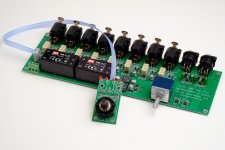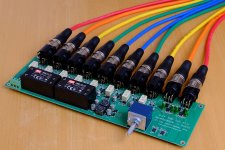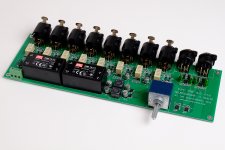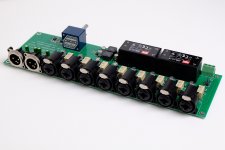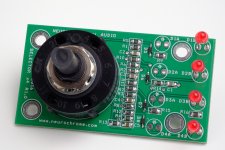Depends on how you are measuring distortion of speakers. It is much different from measuring amplifiers.
Not really. You measure the power of the fundamental and the power of the harmonics. The THD is the ratio between the two. All speaker measurement software I've used have been able to take these measurements and plot THD vs frequency for you.
Tom
You are assuming the mic only captures direct output from the driver. This is almost never possible when measuring speakers.
I know Tom is quite rightly steering this thread back to the Modulus-86 but just a quick note re my recent experiences with speakers. In recent history I have owned Dynaudio Contour 1.8 Mk II and Proac Response 1.5 speakers neither of which is particularly bass shy especially the Dynaudios. However, I prefer the Frugel Horn XLs to both these.
Seriously! ? Gotta get out of the Basement a bit more my friend.
MY Frugals are certainly OK.. but hardly worth Bragging about.
I no longer use them.. they've impressed me that much.
I won't be praising them to all.
What makes your examples so different?
Last edited:
Let's timeout here for a second. UK and American/canadian homes are built in completely different ways and sizes. A speaker that sounds balanced in a std North american dwelling will be bass heavy in a UK home. Comparisons are well night on impossible unless we are talking apartments when you might get closer.
And we don't have basements. We have cellars or dungeons 😛
And we don't have basements. We have cellars or dungeons 😛
Everyone's entitled to an opinion although best not to get offensive. As I said, it is my preference. Room size is reasonable at 24x14 feet and the commercial speakers did not boom and I was very happy with them for a long time. Oh, I haven't got a basement, cellar or dungeon😀
Physics. Always seems to get in the way. It just ain't right! I'd stand up to this crap, but gravity pulls me right back. 🙂
Tom
Tom
Bridged Parallel-86
I have ordered a few Parallel-86 boards recently. When assembled, the amps will be used to drive speakers having an impedance minimum of 4 Ohm.
Still not 100 % sure if a bridged setup would fit or if it has some disadvantages regarding THD+N specs.
My thought so far:
Pros:
- higher output power
- cancellation/decrease of even harmonics
Cons:
- power consumption
- circuit for DC protection or other failures is recommended
- each half of bridge got to drive half of speaker impedance (4 Ohm -> 2 Ohm), rail voltage must be reduced to 20? V
- costs
Would there be an overall improvement/worsening of noise and THD specs when using the Parallel-86 in bridged mode?
Any ideas or experience?
@Tom
Did you eventually already perform some measurements with 2 Ohm loads or of a bridged configuration?
BR,
1543
I have ordered a few Parallel-86 boards recently. When assembled, the amps will be used to drive speakers having an impedance minimum of 4 Ohm.
Still not 100 % sure if a bridged setup would fit or if it has some disadvantages regarding THD+N specs.
My thought so far:
Pros:
- higher output power
- cancellation/decrease of even harmonics
Cons:
- power consumption
- circuit for DC protection or other failures is recommended
- each half of bridge got to drive half of speaker impedance (4 Ohm -> 2 Ohm), rail voltage must be reduced to 20? V
- costs
Would there be an overall improvement/worsening of noise and THD specs when using the Parallel-86 in bridged mode?
Any ideas or experience?
@Tom
Did you eventually already perform some measurements with 2 Ohm loads or of a bridged configuration?
BR,
1543
The unit is so low in THD not really worth worrying about IMHO. Question to be asked is how much power you want. And then re-ask it as how much power you NEED. The 2 are often 10dB apart 🙂
My own personal view (YMMV batteries not included) is that if you want to go over 120w/4Ohms it's time to chose a different technology.
My own personal view (YMMV batteries not included) is that if you want to go over 120w/4Ohms it's time to chose a different technology.
In a bridged amp, each amp half "sees" half the load impedance, so each PAR86 is loaded by 2 Ω.
The PAR86 will provide 14 A of output current, hence, the max guaranteed output swing is 14*2 = 28 V peak.
I've run the PAR86 with a 2 Ω load and it performs very well. The THD is slightly higher than for the 4 Ω case, as you'd expect. It also does a very nice job at heating up a heat sink. You'll need a big one! I used a 0.4 K/W heat sink (measuring about 300 x 150 x 50 mm and weighing in at about 2 kg/each). The heat sink reached about 40-45 ºC. You can probably fit both amp halves on there and have them survive.
You will need a good thermal pad between the IC and the heat sink. I recommend SilPad 1500ST.
I wouldn't put too much faith in harmonic cancellation as a distortion reduction mechanism in a bridged amp. Most cancellation schemes usually perform worse than the original (un-canceled) circuit due to mismatch between the original circuit and the cancellation circuit. I have found a few exceptions, but this is my general observation.
I haven't measured the PAR86 in bridged mode. I'd expect a degradation in THD similar to the degradation from MOD86 to PAR86. So a measurable, but likely not meaningful, degradation in THD.
I support Bill's notion of figuring out how much power is *needed* and designing the amp to meet this requirement.
Tom
The PAR86 will provide 14 A of output current, hence, the max guaranteed output swing is 14*2 = 28 V peak.
I've run the PAR86 with a 2 Ω load and it performs very well. The THD is slightly higher than for the 4 Ω case, as you'd expect. It also does a very nice job at heating up a heat sink. You'll need a big one! I used a 0.4 K/W heat sink (measuring about 300 x 150 x 50 mm and weighing in at about 2 kg/each). The heat sink reached about 40-45 ºC. You can probably fit both amp halves on there and have them survive.
You will need a good thermal pad between the IC and the heat sink. I recommend SilPad 1500ST.
I wouldn't put too much faith in harmonic cancellation as a distortion reduction mechanism in a bridged amp. Most cancellation schemes usually perform worse than the original (un-canceled) circuit due to mismatch between the original circuit and the cancellation circuit. I have found a few exceptions, but this is my general observation.
I haven't measured the PAR86 in bridged mode. I'd expect a degradation in THD similar to the degradation from MOD86 to PAR86. So a measurable, but likely not meaningful, degradation in THD.
I support Bill's notion of figuring out how much power is *needed* and designing the amp to meet this requirement.
Tom
Last edited:
PAR86 deliveres 120W / 4 Ω, thats actually more I do need and my speakers and ears would survive longterm
Bridged scheme with 4 Ω load pushes the LM4780 to its limit and would require adequate cooling as you desribed. Almost more than my class a heaters emmitts 😉 My hope was that the bridged scheme would offer further improvements of THD specs. This is theoretically possible for some figures but many others worsen.
Most important is first Watt and according to your measurements MOD86 to PAR86 do already a very good job at low output levels.
I do not continue the idea of bridging the Parallel-86.
Other question. Do the ESD protection zeners would harm when use them in combination with THAT1200 differential input amplifier? Just to be able to replace THAT1200 with THAT1203 or TAHT1206 later without having to unsolder some parts.
Bridged scheme with 4 Ω load pushes the LM4780 to its limit and would require adequate cooling as you desribed. Almost more than my class a heaters emmitts 😉 My hope was that the bridged scheme would offer further improvements of THD specs. This is theoretically possible for some figures but many others worsen.
Most important is first Watt and according to your measurements MOD86 to PAR86 do already a very good job at low output levels.
I do not continue the idea of bridging the Parallel-86.
Other question. Do the ESD protection zeners would harm when use them in combination with THAT1200 differential input amplifier? Just to be able to replace THAT1200 with THAT1203 or TAHT1206 later without having to unsolder some parts.
Other question. Do the ESD protection zeners would harm when use them in combination with THAT1200 differential input amplifier? Just to be able to replace THAT1200 with THAT1203 or TAHT1206 later without having to unsolder some parts.
With the zener diodes in place, the ESD/hot-swap protection would kick in at a higher voltage. That's needed to allow the full signal swing on the THAT1203 and THAT1206. However, for the THAT1200, the inputs shouldn't go beyond the supply rails, so you get better protection with the zener diodes shorted out.
What you could do is to populate the zener diodes and short them out with short pieces of wire or component clippings on the top side of the board. Then if you switch to THAT1203 or 1206 at a later date, all you have to do is desolder the shorting wires.
Tom
; said:What you could do is to populate the zener diodes and short them out with short pieces of wire or component clippings on the top side of the board. Then if you switch to THAT1203 or 1206 at a later date, all you have to do is desolder the shorting wires.
Good idea. I will do so. Thanks.
Hi Tom
I see you are listing a new pre-amp on your site.
Differential Preamp 8×2
Are you going to tell us a bit more about it?
I see you are listing a new pre-amp on your site.
Differential Preamp 8×2
Are you going to tell us a bit more about it?
Hi Tom
I see you are listing a new pre-amp on your site.
Differential Preamp 8×2
Are you going to tell us a bit more about it?
Nah... I figured I'd hide behind my smoke screen for a while... 🙂
Eight differential inputs, two differential outputs configured for four stereo in, one stereo out. Input selection by small-signal relays with gold plated contacts. Alps "Blue Velvet" volume pot. On-board regulated and filtered power supply that takes international mains voltage (85-264 VAC, 47-440 Hz) in. Board size: 10.800 x 3.500 inches.
The little selector board measures 1.300 x 2.400 inches and is designed to be able to fit in a 1U rack mount chassis. The LED for the active input glows brightly and the LEDs for the inactive LEDs glow subtly, creating a nice visual effect on the front panel.
Some quick measurements:
THD+N: Limited by the THAT chips
Noise floor (256K FFT, 16 averages): -140 dBV (give or take)
Channel separation, 1 kHz: Can’t measure (below the noise floor)
Output noise + hum, RMS, IN 1: 22.0 uV (unweighted)
Output noise + hum, RMS, IN 4: 21.5 uV (unweighted)
Output noise + hum, RMS, IN 1: 18.9 uV (A weighted)
Output noise + hum, RMS, IN 4: 18.5 uV (A weighted)
I expect to have some actual specs and description page on my website by the end of the coming week. I've attached some eye candy for you to drool over. 🙂
Tom
Attachments
Last edited:
Hi Tom
My build is progressing slowly (work, life, etc, and just taking my time), however I'm at the stage of wiring it all up. What's the maximum current each board will pull from the power supply (8 ohm load and 35V rails)? I need to make sure I get wire that can handle the amps pulled from the power supply.
Cheers
My build is progressing slowly (work, life, etc, and just taking my time), however I'm at the stage of wiring it all up. What's the maximum current each board will pull from the power supply (8 ohm load and 35V rails)? I need to make sure I get wire that can handle the amps pulled from the power supply.
Cheers
And suddenly the thread springs back to life. 🙂 I was afraid my awesome preamp specs left everybody speechless. I added some more specs on my Differential Preamplifier 8x2 website.
The amount of current drawn from the power supply depends on the load current, which again depends on the music signal. If we're assuming sine wave operation, I find 0.35*Ipeak to be a reasonable estimate of the RMS current per supply lead.
So for 8 Ω, 35 V operation, you'll have Isupply = 0.35 * 35/8 = 1.5 A in each supply lead. The GND connection carries twice that current. As do the speaker connections.
Tom
What's the maximum current each board will pull from the power supply (8 ohm load and 35V rails)? I need to make sure I get wire that can handle the amps pulled from the power supply.
The amount of current drawn from the power supply depends on the load current, which again depends on the music signal. If we're assuming sine wave operation, I find 0.35*Ipeak to be a reasonable estimate of the RMS current per supply lead.
So for 8 Ω, 35 V operation, you'll have Isupply = 0.35 * 35/8 = 1.5 A in each supply lead. The GND connection carries twice that current. As do the speaker connections.
Tom
Tom
Hey Tom I would like to see some specifications THD at the lower end of the spectrum like 20 cycles 60 cycles both for your amp and the preamp....
they both look fantastic btw...
Lawrence
P.S when you send the amp dont forget the preamp too 😀
Hey Tom I would like to see some specifications THD at the lower end of the spectrum like 20 cycles 60 cycles both for your amp and the preamp....
they both look fantastic btw...
Lawrence
P.S when you send the amp dont forget the preamp too 😀
Thank you Tom, that's the explanation I needed (and understood), for the electronics/physics challenged person I am.
Edit: Ah, yes, Ohms law, should have realised it would have something to do with this. Note to self - remember the basics.
Edit: Ah, yes, Ohms law, should have realised it would have something to do with this. Note to self - remember the basics.
Last edited:
- Home
- Amplifiers
- Chip Amps
- Modulus-86 build thread
